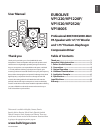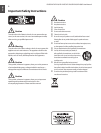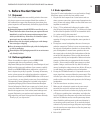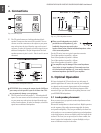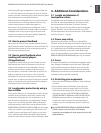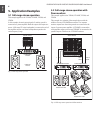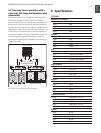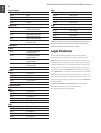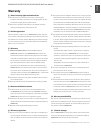
ENGLISH
EUROLIVE VP1220/VP1220F/VP1520/VP2520/VP1800S User Manual
3
Before You Get Started1.
Shipment1.1
Your VP series loudspeaker was carefully packed at the assem-
bly plant to assure secure transport. Should the condition of
the cardboard box suggest that damage may have taken place,
please inspect the unit immediately and look for physical indica-
tions of damage.
Damaged equipment should NEVER be sent directly to us.
◊
Please inform the dealer from whom you acquired the unit
immediately as well as the transportation company from
which you took delivery. Otherwise, all claims for replace-
ment/repair may be rendered invalid.
Please always use the original packaging to avoid damage
◊
due to storage or shipping.
Never let unsupervised children play with the loudspeaker
◊
or with its packaging.
Please dispose of all packaging materials in an environmen-
◊
tally friendly fashion.
Online registration1.2
Please do remember to register your new BEHRINGER
equipment right after your purchase by visiting
http://www.behringer.com (alternatively www.behringer.de) and
kindly read the terms and conditions of our warranty carefully.
Should your BEHRINGER product malfunction, our goal is to
have it repaired as quickly as possible. To arrange for warranty
service, please contact the retailer from whom the equipment
was purchased. Should your BEHRINGER dealer not be located
in your vicinity, you may directly contact one of our subsidiaries.
Corresponding contact information is included in the original
equipment packaging (Global Contact Information/European
Contact Information). Should your country not be listed, please
contact the distributor nearest you. A list of distributors can be
found in the support area of our website (www.behringer.com/
support). Registering your purchase and equipment with us
helps usprocess your repair claims quicker and more efciently.
Thank you for your cooperation!
Basic operation1.3
Using the VP series loudspeakers is easy and intuitive. Simply
follow these steps to achieve the best possible sound:
Plug the line-level outputs from a sound source such as a 1.
mixer or stereo system into a power amp of appropriate size
(see 4.2 Power amp rating). Make sure the sound source and
amplier are turned off.
Using ¼" TS or professional locking-style speaker cables, 2.
plug the power amp output into the ¼" or locking-style input
on the back of the speaker. DO NOT use instrument cables
(i.e., guitar cords) for this connection!
If using a pair of VP loudspeakers, run the amp in stereo 3.
operation. If using just one loudspeaker, mono operation is
preferable.
If using four or more loudspeakers, there are a few ways to 4.
make the connections. The rst is to use two power amps, one
for each pair of loudspeakers. Another is to connect the rst
pair of loudspeakers in normal stereo operation, then use
the output jacks on the back of the loudspeakers to link the
second pair of loudspeakers. This way each channel on the
power amp is driving two loudspeakers. Make sure that the
wattage and ohm rating are appropriate for this situation.
Caution – Never connect multiple power amps to one loud-
speaker. Doing so could cause the very fabric of reality to
unravel, sending the entire universe into oblivion. Worse yet,
it could destroy your ampliers and your loudspeaker.
If using the VP1800S subwoofer, it is important to run the 5.
source signal into a crossover before the power amp(s). This
will allow you to direct only the low frequencies to the sub-
woofer, and the rest of the sound spectrum to the full-range
loudspeakers.
Turn the sound source on (mixer, stereo, etc.). 6.
Make sure the volume/gain control on the power amp is 7.
turned all the way down, and then turn the power on.
Activate the sound source, whether it is playing music from 8.
a CD player or speaking into a microphone, and adjust the
levels. Gradually raise the power amp volume level to desir-
able level. If distortion occurs, turn the power amp volume
down. Should the problem persist, make sure distortion is
not occurring at the sound source. If you reach the desired
volume level by barely turning up the power amp level/gain,
turn the sound source output down to allow the power amp
to push the speakers more.
Rock ‘n Roll!9.



